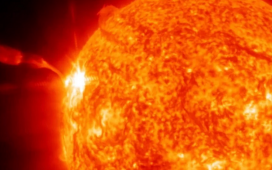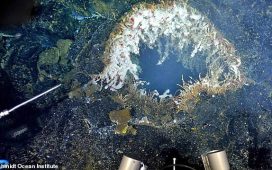A ‘hazardous’ asteroid the size of a football is on course for a close shave with the Earth, a UK scientist has said.
The object, Asteroid 2008 OS7, which measures roughly 900 metres in diameter, will pass by our planet on Friday afternoon – although there’s no risk of a collision.
Referring to an official NASA designation, Dr Minjae Kim, Research Fellow, Department of Physics, University of Warwick, explained: “2008 OS7, a very small asteroid whose orbit intersects with that of Earth, has been classified as a ‘Potentially Hazardous Asteroid (PHA)’.”
Based on information provided by NASA’s Jet Propulsion Laboratory, 2008 OS7 will approach Earth at about 2.41 pm at a distance of roughly 0.01908 au (about 1773596 miles, or 2,854,327 km), at a velocity of 11.3 miles per second (18.167 km/s).
Dr Kim said: “We don’t need to worry about it too much as this asteroid will not enter Earth’s atmosphere, while this will still approach close to the Earth.
“There are millions of asteroids in our Solar System, of which about 2,350 asteroids have been classified as PHAs.
“The next significant approach to Earth by a PHA will be the 99942 Apophis on April 14, 2029.”
The asteroid completed an orbit around the sun every 962 days (2.63 years), Dr Kim explained.
She continued: “One of the most intriguing aspects of the 2008 OS7 is its estimated diameter based on its luminosity and reflective properties, ranging from 0.221 to 0.494 kilometres.
“This places it in the category of a small to moderately sized asteroid, roughly equivalent to the size of a football field.
“Unfortunately, asteroids are generally too faint to have been detected by the current techniques and surveys, so it’s very hard to see by our naked eyes.
“The only asteroid at all visible to the naked eye so far are Pallas and Vesta, having diameters of about 500 km.”
NASA’s Center for Near Earth Object Studies (CNEOS) studies the orbits of all known near-Earth objects, predicts their close approaches with Earth, and makes hazard assessments in support of the agency’s Planetary Defense Coordination Office at NASA Headquarters in Washington.
Near-Earth objects are asteroids and comets which have orbits that bring them to within 120 million miles (195 million kilometres) of the Sun, means they can circulate through what NASA calls “the Earth’s orbital neighbourhood”.
Most near-Earth objects are asteroids ranging in size from about 10 feet (a few metres) to nearly 25 miles (40 kilometres) across.
A statement on NASA’s website explains: “The majority of near-Earth objects have orbits that don’t bring them very close to Earth, and therefore pose no risk of impact, but a small fraction of them – called potentially hazardous asteroids – require more attention.
“These objects are defined as asteroids that are more than about 460 feet (140 metres) in size with orbits that bring them as close as within 4.6 million miles (7.5 million kilometres) of Earth’s orbit around the Sun.
“CNEOS continuously monitors all known near-Earth objects to assess any impact risk they may pose.”
In total, five objects will pass close to the Earth between now and Friday.
Apart from 2008 OS7, 2024 BR3 (100 feet), 2024BR (63 feet), 2003 BM03 (120 feet) and 2024 BJ03 (73 feet) will all put in fleeting appearances.











